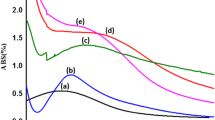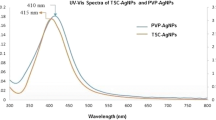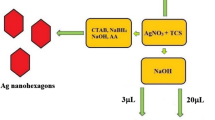Abstract
Silver nanoparticles (AgNPs) have good antibacterial activity and their morphologies have important influence on their activity. The relationship between their bactericidal property and morphology has not been studied thoroughly. Silver triangular nanoplates have basic {111} surface, nanospheres and nanocubes mainly have {100} planes, and nanorods have {100} side surfaces and {111} end facets. It was said that {111} crystal plane of AgNPs may play a prime role in antibacterial progress. Moreover, the antibacterial activity of nanocubes is not very clear when compared to nanoparticles with other morphologies. In this paper, we studied the antibacterial activity of nanocubes and attempted to confirm whether nanoparticles with {111} crystal facet truly had stronger antibacterial activity than other nanoparticles. We prepared four kinds of AgNPs and found silver triangle nanoplates had the best antibacterial activity, while nanospheres, nanocubes and short nanorods showed similar efficacy. It may provide a reference for safe application of AgNPs with different morphologies in the medical field.



Similar content being viewed by others
References
C. Nathan, O. Cars, Antibiotic resistance—problems, progress, and prospects. N. Engl. J. Med. 371, 1761–1763 (2014)
K.A. Eid, H.M. Azzazy, Sustained broad-spectrum antibacterial effects of nanoliposomes loaded with silver nanoparticles. Nanomedicine 9, 1301–1310 (2014)
G.Y. Zhang, F. Zhang, H. Morikawa et al., One-step synthesis of silver nanoparticles in an aqueous solution and their antibacterial activities. Appl. Phys. A Mater. Sci. Process. 114, 1277–1283 (2014)
K. Singh, Evaluation of antimicrobial activity of synthesized silver nanoparticles using Phyllanthus amarus and Tinospora cordifolia medicinal plants. J. Nanomed. Nanotechnol. 05 (2014). doi:10.4172/2157-7439.1000250
K. Singh, Antibacterial activity of synthesized silver nanoparticles from Tinospora cordifolia against multi drug resistant strains of Pseudomonas aeruginosa isolated from burn patients. J. Nanomed. Nanotechnol. (2014). doi:10.4172/2157-7439.1000192
K. Singh, M. Panghal, S. Kadyan et al., Green silver nanoparticles of Phyllanthus amarus: as an antibacterial agent against multi drug resistant clinical isolates of Pseudomonas aeruginosa. J. Nanobiotechnol. 12 (2014). doi:10.1186/s12951-014-0040-x
M. Tsuji, K. Matsumoto, N. Miyamae et al., Rapid preparation of silver nanorods and nanowires by a microwave-polyol method in the presence of Pt catalyst and polyvinylpyrrolidone. Cryst. Growth Des. 7, 311–320 (2006)
M. Tsuji, K. Matsumoto, P. Jiang et al., Roles of Pt seeds and chloride anions in the preparation of silver nanorods and nanowires by microwave-polyol method. Colloids Surf. Physicochem. Eng. Asp. 316, 266–277 (2008)
Y.-M. Chang, I.-T. Lu, C.-Y. Chen et al., High-yield water-based synthesis of truncated silver nanocubes. J. Alloys Compd. 586, 507–511 (2014)
Y.K. Tak, S. Pal, P.K. Naoghare et al., Shape-dependent skin penetration of silver nanoparticles: does it really matter? Sci. Rep. 5, 16908–16918 (2015)
J.R. Morones, J.L. Elechiguerra, A. Camacho et al., The bactericidal effect of silver nanoparticles. Nanotechnology 16, 2346–2353 (2005)
S. Pal, Y.K. Tak, J.M. Song, Does the antibacterial activity of silver nanoparticles depend on the shape of the nanoparticle? A study of the gram-negative bacterium Escherichia coli. Appl. Environ. Microbiol. 73, 1712–1720 (2007)
W. Lu, K. Yao, J. Wang et al., Ionic liquids–water interfacial preparation of triangular Ag nanoplates and their shape-dependent antibacterial activity. J. Colloid Interface Sci. 437, 35–41 (2015)
W.Z. Zhang, X.L. Qiao, Q.Y. Chen et al., The influence of synthesis condition and aging process of silver nanocrystals on the formation of silver nanorods. Appl. Surf. Sci. 258, 5909–5913 (2012)
W.Z. Zhang, W. Zhang, X.L. Qiao et al., Controllable preparation of silver nanostructures and the effects of acidity–basicity of the reaction system. Sci. Adv. Mater. 6, 304–311 (2014)
D. Yu, V.W. Yam, Controlled synthesis of monodisperse silver nanocubes in water. J. Am. Chem. Soc. 126, 13200–13201 (2004)
V. Germain, A. Brioude, D. Ingert et al., Silver nanodisks: size selection via centrifugation and optical properties. J. Chem. Phys. 122, 124707–124715 (2005)
H. Wu, L. He, M. Gao et al., One-step in situ assembly of size-controlled silver nanoparticles on polyphenol-grafted collagen fiber with enhanced antibacterial properties. New J. Chem. 35, 2902–2909 (2011)
Y. Zhang, X. Cheng, Y. Zhang et al., Biosynthesis of silver nanoparticles at room temperature using aqueous aloe leaf extract and antibacterial properties. Colloids Surf. Physicochem. Eng. Asp. 423, 63–68 (2013)
C. Marambio-Jones, E.M. Hoek, A review of the antibacterial effects of silver nanomaterials and potential implications for human health and the environment. J. Nanopart. Res. 12, 1531–1551 (2010)
Z.-M. Xiu, Q.-B. Zhang, H.L. Puppala et al., Negligible particle-specific antibacterial activity of silver nanoparticles. Nano Lett. 12, 4271–4275 (2012)
C.-N. Lok, C.-M. Ho, R. Chen et al., Proteomic analysis of the mode of antibacterial action of silver nanoparticles. J. Proteome Res. 5, 916–924 (2006)
V. Kumar, C. Jolivalt, J. Pulpytel et al., Development of silver nanoparticle loaded antibacterial polymer mesh using plasma polymerization process. J. Biomed. Mater. Res. Part A 101, 1121–1132 (2013)
S. Kar, B. Bagchi, B. Kundu et al., Synthesis and characterization of Cu/Ag nanoparticle loaded mullite nanocomposite system: a potential candidate for antimicrobial and therapeutic applications. Biochim. Biophys. Acta Gener. Subj. 1840, 3264–3276 (2014)
S. Chernousova, M. Epple, Silver as antibacterial agent: ion, nanoparticle, and metal. Angew. Chem. Int. Ed. 52, 1636–1653 (2013)
C.-N. Lok, C.-M. Ho, R. Chen et al., Silver nanoparticles: partial oxidation and antibacterial activities. J. Biol. Inorg. Chem. 12, 527–534 (2007)
J.J. Antony, P. Sivalingam, D. Siva et al., Comparative evaluation of antibacterial activity of silver nanoparticles synthesized using Rhizophora apiculata and glucose. Colloids Surf. B Biointerfaces 88, 134–140 (2011)
A.M. Fayaz, K. Balaji, M. Girilal et al., Biogenic synthesis of silver nanoparticles and their synergistic effect with antibiotics: a study against gram-positive and gram-negative bacteria. Nanomed. Nanotechnol. Biol. Med. 6, 103–109 (2010)
X. Cao, M. Tang, F. Liu et al., Immobilization of silver nanoparticles onto sulfonated polyethersulfone membranes as antibacterial materials. Colloids Surf. B Biointerfaces 81, 555–562 (2010)
S. Shrivastava, T. Bera, A. Roy et al., Characterization of enhanced antibacterial effects of novel silver nanoparticles. Nanotechnology 18, 225103–225112 (2007)
H.H. Lara, N.V. Ayala-Núnez, L.D.C.I. Turrent et al., Bactericidal effect of silver nanoparticles against multidrug-resistant bacteria. World J. Microbiol. Biotechnol. 26, 615–621 (2010)
Y. Sun, Y. Xia, Shape-controlled synthesis of gold and silver nanoparticles. Science 298, 2176–2179 (2002)
A. Ivask, K. Juganson, O. Bondarenko et al., Mechanisms of toxic action of Ag, ZnO and CuO nanoparticles to selected ecotoxicological test organisms and mammalian cells in vitro: a comparative review. Nanotoxicology 8, 1–15 (2013)
A. Ojha, S. Forster, S. Kumar et al., Synthesis of well-dispersed silver nanorods of different aspect ratios and their antimicrobial properties against gram positive and negative bacterial strains. J. Nanobiotechnol. 11, 42–48 (2013)
Acknowledgments
The Project was supported by the National Natural Science Foundation of China (Grant No. 81071254) and the Natural Science Foundation of Guangdong Province, China (Grant No. 10451051501004706). We would like to thank Prof. Zhengchao Tu and his research team (High Throughput Drug Screening Center, Guangzhou Institutes of Biomedicine and Health, Chinese Academy of Sciences) for the antibacterial test of the nanomaterials. We also thank the Product Manager, Zemin Chen, from A&P Instrument Co. Ltd. for his assistance in the NTA measurements.
Author information
Authors and Affiliations
Corresponding authors
Rights and permissions
About this article
Cite this article
Hu, G., Jin, W., Chen, Q. et al. Antibacterial activity of silver nanoparticles with different morphologies as well as their possible antibacterial mechanism. Appl. Phys. A 122, 874 (2016). https://doi.org/10.1007/s00339-016-0395-y
Received:
Accepted:
Published:
DOI: https://doi.org/10.1007/s00339-016-0395-y




